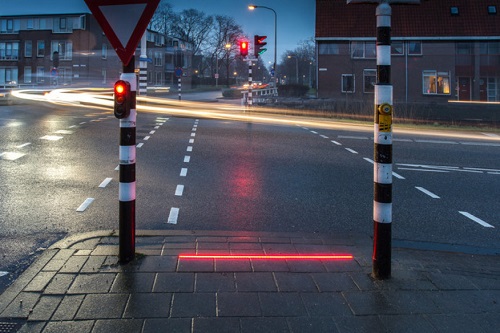








In order to keep distracted pedestrians from walking into oncoming traffic, the city of Bodegraven in the Netherlands has implemented a pilot project called +Lightlines by HIG Traffic Systems that is testing LED strips embedded into the edges of sidewalks. The LEDs, which are synced and color-coordinated with traffic lights, can be found in strategic cracks in the pavement for downward-looking walkers. Though clever, this solution is being criticized for "rewarding bad behavior," according to an official from Dutch road safety lobby group Veilig Verkeer Nederland. [Engadget]
A team of engineers from the University of Colorado Boulder has created an eco-friendly, 50-micrometer-thick, "glass-polymer hybrid material" that can cool structures by reflecting solar energy. The result of a 2015 $3 million grant from the U.S. Department of Energy, the microfilm can be manufactured in large rolls and applied directly to surfaces such as roofs or exteriors of power plants. The team plans to build a 200-square-meter "cooling-farm prototype" later this year.
Disney Research has developed a metalized room that charges technology wirelessly. Built with aluminum panels, the room has a central copper pole through which electrical currents travel 1.3 million times per second, creating a magnetic field to power multiple devices at a time.
A bill proposing completely switching electricity generation in state of Massachusetts to renewable energy sources, like solar and wind, by the year 2035 has been co-sponsored by 53 state legislators in the House and Senate on Feb. 13. If passed, the "An Act Transitioning Massachusetts to 100 Percent Renewable Energy" bill would make Massachusetts the first state in the U.S. to achieve this energy goal. "Massachusetts has been a leader on alternative energy policy for over a decade, and now with federal assaults on efforts to combat climate change, it will be up to individual states to protect the environmental and health interests of the public," said State Sen. Jamie Eldridge. [Environment Massachusetts]
Transportation authority of Dubai has begun testing self-driving hover-taxis created by Chinese drone manufacturer EHang. The one-man vehicle is powered by eight propellers, can travel up to 60 mph, for as long as 30 minutes, and up to 1,000 feet high. The city hopes to introduce the transportation technology by July.
Alphabet (Google's parent company, created during the internet giant's last restructuring) is moving hundreds of employees off the Google Fiber division and to other parts of the company. It started cutting back on Fiber's growth last fall by canceling some extensions and other possible expansions in an effort to focus more on wireless broadband.
New Mexico–based company mPower Technology has developed virtually unbreakable miniaturized solar panel technology by creating glitter-sized cells made of high-efficiency silicon. These cells can be manufactured into pliable sheets that "can be folded up for transportation, incorporated into clothing, or easily used in electronics" according to an article in Co.Exist. MPower CEO Murat Okandan believes this technology could help reduce the cost of roof solar panel installation and might prove more resilient as malfunctions in the individual cells will not corrupt the entire sheet. Murat first created the technology at Sandia National Laboratories. [Co.Exist]
Rice University researchers have developed a highly conductive graphene foam that is reinforced with carbon nanotubes. The porous "rebar graphene" can be molded into different shapes and support more than 3,000 times its weight and still regain its height.
Copyright 2006-2025 Shanghai Sinoexpo Informa Markets International Exhibition Co., Ltd. All rights reserved